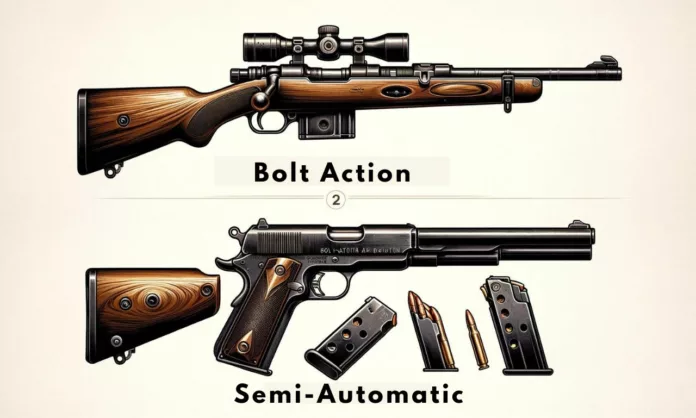Firearm actions, the mechanism by which guns load, fire, and eject ammunition, are essential to their design and function. Understanding these mechanisms is crucial for anyone involved in shooting sports, hunting, or firearm maintenance. There are two basic styles of firearm actions: single-shot and repeating. This article will explore each style in detail, providing insights into their mechanisms, advantages, and common applications.
Table of Contents
Single-Shot Actions
Single-shot firearms are designed to accommodate and discharge a single round of ammunition with each operation. After firing, the shooter must manually reload the gun before it can be fired again. This simplicity lends itself to a few key advantages and common uses.
Break-Action
- Mechanism: Break-action firearms have a barrel (or barrels) that hinges open to allow loading and unloading of ammunition. This action is operated by a lever or a button that breaks the gun open at the breech (the rear part of the barrel).
- Advantages: The simplicity of the break-action design makes these firearms lightweight and easy to maintain. They are also considered very safe due to the clear visual indication of the gun being open and unloaded.
- Common Uses: Break-action firearms are popular in shotguns and rifles used for hunting and clay pigeon shooting, where the precision of a single, well-aimed shot is valued over rapid fire.
Falling Block
- Mechanism: A falling block action involves a solid metal block moving vertically in a slot cut into the breech of the gun to open or close the breech. This action is typically operated by a lever.
- Advantages: This design allows for a very strong breech, making it capable of handling high-pressure cartridges, which is ideal for long-range precision shooting.
- Common Uses: Falling block actions are often found in target and varmint rifles, where accuracy and the ability to handle powerful cartridges are paramount.
Repeating Actions
Repeating firearms have a mechanism that allows them to be loaded with multiple rounds of ammunition at once, enabling the shooter to fire several shots in quick succession without reloading.
Bolt-Action
- Mechanism: In a bolt-action firearm, the shooter manually operates the bolt by opening and closing it via a handle to eject a spent cartridge and chamber a new one from the magazine.
- Advantages: Bolt-action rifles are renowned for their accuracy and reliability. The locking lugs on the bolt provide a very secure closure for the breech, making these rifles capable of precision shooting.
- Common Uses: Hunters and target shooters highly favor bolt-action rifles for their precision and straightforward design.
Semi-Automatic Action
- Mechanism: Semi-automatic firearms automatically eject the spent cartridge and load a new one into the chamber after each shot, using the energy from the fired round. The shooter can then fire another shot by simply pulling the trigger again.
- Advantages: The main advantage of semi-automatic firearms is their rapid rate of fire, as they eliminate the need for manual action between shots, which is crucial in tactical and self-defense situations.
- Common Uses: Semi-automatic actions are common in pistols, rifles, and shotguns used for a wide range of purposes, including law enforcement, military, self-defense, and competitive shooting.
Conclusion
The choice between single-shot and repeating actions depends on the specific needs and preferences of the shooter. Single-shot firearms offer simplicity, reliability, and the discipline of making each shot count, making them ideal for hunting and precision shooting. Repeating firearms provide the advantage of multiple shots without the need to reload, which can be crucial in dynamic shooting environments or when facing multiple targets. Understanding these basic styles of firearm actions allows individuals to make informed decisions about which type of firearm best suits their intended use, ensuring both safety and effectiveness in their shooting activities.

